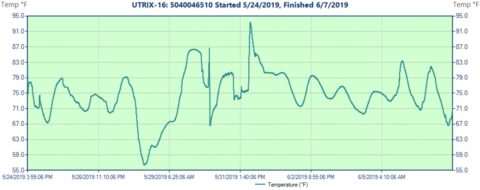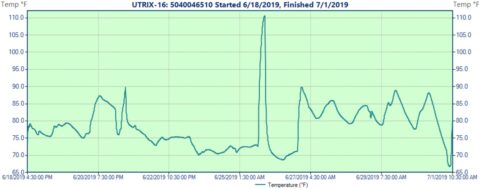Every year as temperatures start to increase, we get phone calls and emails inquiring how to protect Aprehend from summer temperatures. Many questions are specific to the high temperatures during transit (FedEx, UPS etc.). The biggest concern is that spores will be adversely impacted by temps in the back of a delivery truck.
So, we did some experiments to see what really happens in the back of those trucks. What we found may surprise you. We shipped a bottle of Aprehend along with a temperature data logger to Phoenix, Arizona and Salina, Kansas. The bottle was immediately returned to us in central Pennsylvania using the same shipping method (Figure 1). Upon return, we compared the viability of Aprehend (as measured by % germination) to the viability tested immediately after bottling.
In both cases, when Aprehend was tested upon return, the spores showed 95% viability, similar to the date they were bottled.


Figure 1 Temperature data logger results from shipment to Arizona (top) and Kansas (bottom) and returning to Pennsylvania. Note: the temperature spike of 111°F did not occur during transit with the carrier. This temperature spike occurred in the private vehicle when the bottle was being dropped off at the carrier for return to ConidioTec.
Click here to download the “Summer is Here!” Field Notes for the full story.
The most important factor in protecting Aprehend from summer temperatures is the storage of the product once it is received by the PMP (NOT temperatures during transit). We have pulled together some useful tips for the best lifetime and performance of Aprehend.
Click here for Aprehend storage and temperature tips.
See how other PMPs have used Aprehend in a variety of difficult situations in these Case Studies and suggested prep steps and proper equipment usage with these Training Videos and the Educational Series on our YouTube channel. Give us a call at (800) 891-8610 and we can discuss how to integrate Aprehend into your current protocol, reduce call-backs, and eliminate the most difficult bed bug infestations.

